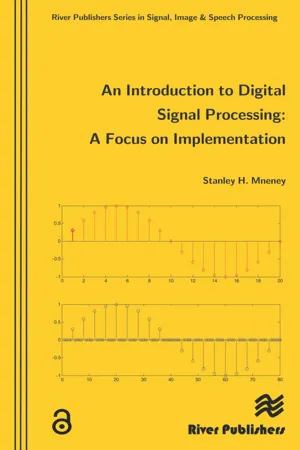
- 284 pages
- English
- ePUB (mobile friendly)
- Available on iOS & Android
An Introduction to Digital Signal Processing
About This Book
An Introduction to Digital Signal Processing aims at undergraduate students who have basic knowledge in C programming, Circuit Theory, Systems and Simulations, and Spectral Analysis. The book is focused on basic concepts of digital signal processing, MATLAB simulation and implementation on selected DSP hardware in which the candidate is introduced to the basic concepts first before embarking to the practical part which comes in the later chapters. Initially Digital Signal Processing evolved as a postgraduate course which slowly filtered into the undergraduate curriculum as a simplified version of the latter. The goal was to study DSP concepts and to provide a foundation for further research where new and more efficient concepts and algorithms can be developed. Though this was very useful it did not arm the student with all the necessary tools that many industries using DSP technology would require to develop applications. This book is an attempt to bridge the gap. It is focused on basic concepts of digital signal processing, MATLAB simulation and implementation on selected DSP hardware. The objective is to win the student to use a variety of development tools to develop applications. Contents• Introduction to Digital Signal processing.• The transform domain analysis: the Discrete-Time Fourier Transform• The transform domain analysis: the Discrete Fourier Transform• The transform domain analysis: the z-transform• Review of Analogue Filter• Digital filter design.• Digital Signal Processing Implementation Issues• Digital Signal Processing Hardware and Software• Examples of DSK Filter Implementation
Frequently asked questions
Information
Table of contents
- Cover
- Half Title
- Title Page
- Copyright Page
- Dedication
- Acknowledgments
- About the Author
- Preface
- Table of Contents
- 1 Introduction to Digital Signal Processing
- 2 The Transform Domain Analysis: The Discrete-Time Fourier Transform
- 3 The Transform Domain Analysis: The Discrete Fourier Transform
- 4 The Transform Domain Analysis: The z-Transform
- 5 Review of Analog Filter Design
- 6 Digital Filter Design
- 7 Digital Signal Processing Implementation Issues
- 8 Digital Signal Processing Hardware and Software
- 9 Examples of DSK Implementations
- References
- Appendix
- Index